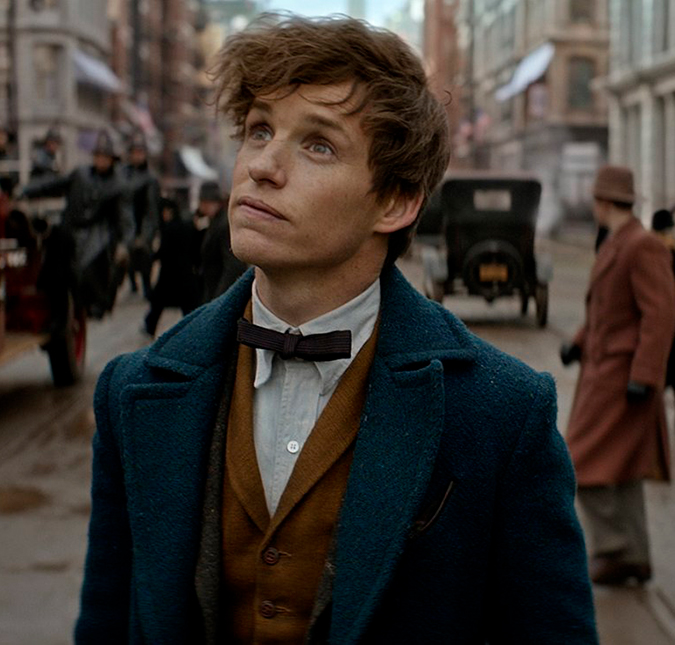That was my biggest concern ever since the film was announced. Originally meant as a solo outing, it quickly stretched to a trilogy and then a quintilogy. The films were to centre around Newt Scamander, whose worldly travels with a magical briefcase would lead him through many shenanigans. The films would also tie-in with the canon proper, including a subplot surrounding the rise and fall of Gillert Grindelwald, to keep long-time Potter fans invested. It seemed almost pointless to make these films, especially since we didn’t need them. Still, they were being written by JK Rowling, so I gave this first movie a shot.
And, in all honesty, it’s actually quite decent. It won’t win any awards or anything, nor does it rival the best of the Harry Potter films, but I found myself surprisingly enjoying it. Even taking out the mixed expectations, there’s a viable argument in hindsight for this sort of world building exercise that makes it well-worth your time. The main reason is that, when you remove the decently-written story, there’s actually room to build on the Harry Potter lore.
I won’t give away the plot, since it’s not that deep and is best experienced blind, but it definitely compensates for feeling somewhat, if Bob Chipman’s review is anything to go by, fan-fiction heavy. Those familiar with Harry Potter lore will be well-acquainted with characters like Scamander and Grindenwald, and that’s really whom this film is meant for. It’s not breaking new territory, nor will it appeal to the unconverted, but for those who grew up with Rowling’s classic series (like me) and watched all 8 prior films in theatres, it’ll definitely feel like a homecoming. For everyone else, it’s a period-piece action drama set in the US, one that’s definitely entertaining in spite of its shortcomings.
Of which there are a few. I’m not in entire agreement with Chipman, I find that he sometimes gets too fixated on details and uses them to be overly-critical, but I’ll be the first to point out that Eddie Redmayne isn’t the best choice for a movie to centre around. I don’t hate him, he’s proven himself a great physical actor, but he can definitely be grating and has limited range. The movie didn’t need to pick him as the lead, it could’ve easily gone to someone else, but I guess it’s too late to complain about that.
The movie also feels like an exercise in shameless world building every-now-and-then. It mostly holds up, but it’ll occasionally drop a reference that no one but die-hards will get. It’s a tactic that the MCU is guilty of too, except that the MCU also generally shows restraint. This movie doesn’t, even shamelessly setting itself up for sequels from the get-go, and it can be grating. Besides, not every franchise needs to be an MCU-rip-off.
The film also divulges into several subplots, leaving its main story, which is pretty short, on the back-burner. There’s a story involving a side-character and his personal life, which is resolved in the final scene. There’s a story involving another side-character and his personal life, which becomes the third-act climax. And there’s a story about a third side-character and her fall from grace, which is resolved in the film’s resolution. There’s even a completely-last-minute-yet-still-fitting twist that’s left open for a sequel on purpose. All of these subplots are fine, but they can feel cluttered amidst a really short main story.
Speaking of side-characters, I should address the elephant in the room and mention Johnny Depp. He plays a really minor role, but his presence, especially in-light of recent allegations of abuse, is bound to anger many people. I can’t say they’re wrong, abuse is abuse, but too many actors and actresses these days have skeletons in their closets. We should be critical of their foul behaviour, but, like I argued in my previous blog entry, boycotting on principle leaves you avoiding far too much quality art. Not like Fantastic Beasts and Where to Find Them is a masterpiece, but my philosophy of differentiating art from artist remains intact.
The visual effects are also amazing. Many past Harry Potter films, particularly some of the later ones, have been accused of lacklustre CGI, due in part to their short gestation cycles, yet were easily forgiven due to strong writing and acting. This movie seems to have learned that lesson, as every special effect, right down to the floating scenes, is well-designed and weighty, making them the most-believable of all the Harry Potter films to-date. It’s also gorgeous to boot.
Like I said earlier, I was pleasantly surprised by Fantastic Beasts and Where to Find Them. It’s nothing amazing, but neither were half of the Harry Potter films, and I still enjoyed them. Besides, it did the impossible and managed to copy the MCU’s world building without it feeling forced, something not even The Hobbit Trilogy could do. If the movie can pull that off, on top of being enjoyable, then it’s doing something right!





